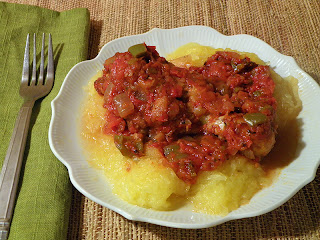 |
| Served over Spaghetti Squash |
Recipe by Robin
One way to almost guarantee success with a recipe that you
haven’t tried before is to make something with tomato sauce or crushed
tomatoes. Your chances of success are even greater if you use homemade tomato
sauce and/or homemade stewed
tomatoes. Add a little wine for even higher odds of success. Case in point:
I have only made chicken cacciatore twice but both times it was
enthusiastically enjoyed and compliments rolled in. The first success was back
in yesteryear when feeding an under-appreciative boyfriend with a recipe from
the new 1985 Joy
of Cooking. The second success was at a recent dinner party where my
husband hoped that I knew what I was doing when I made up a recipe at the last
minute. It’s hard to go wrong with
variations on this recipe, as long as you use a wine that you’d consider
drinking. It doesn’t need to be expensive wine. I used a 2001 Two Buck Chuck
Shiraz. Yeah, I might consider drinking that if the occasion were right, though
it’s even better for cooking.
 |
| Step 1: Brown Plump Organic Chicken |
 |
| Step 2: Make Chunky Tomato Sauce |
 |
| Step 3: Stew Chicken in Tomato Sauce |
I like to brown chicken more than most people do, which I
think improves its flavor. An electric
frying pan is helpful for this because it heats evenly and you can control
the temperature exactly. Browning the chicken more also cooks out more of the
fat. Note that organically fed free-range
chickens have substantially less fat than factory-farmed chickens, in
addition to being more humanely raised.
Go ahead and test my original premise that recipes with
crushed tomatoes and tomato sauce are almost guaranteed to be successful by
making your own additions and substitutions. Add a comment to let us know come
up with a tasty variation.
serves 6 - 8
3½ lbs. chicken legs
~½ tsp. salt
~¼ tsp. pepper
1½ tbsp. olive oil
½ tbsp. olive oil
1 medium onion (~9 oz.)
½ lb. green bell pepper (1-2)
3-4 cloves garlic
2 tbsp. tomato paste
~2 lb. 11 oz stewed
tomatoes, OR 3 - 14.5 oz cans crushed tomatoes
½ cup dry red wine
1 tsp. dried oregano
½ tsp. dried marjoram
¼ tsp. dried thyme
¼ tsp. salt
1/8 tsp. pepper
parsley (optional garnish)
Separate chicken thighs from drumsticks. Remove any excess
fat. Sprinkle with about ½ teaspoon of salt and ¼ teaspoon pepper.
Heat an electric
frying pan to 400 degrees F., or heat a large skillet over medium high.
When hot, add 1½ tbsp. olive oil and fry chicken parts until brown, about 15-18
minutes, turning frequently. You might want to use a grease
screen to cut down on splatters.
While chicken is cooking, chop onions into medium dice,
about ½ inch. Dice bell peppers the same size. Peel and mince garlic.
When chicken is brown, remove from frying pan and drain on
towel. Blot oil from top of chicken. Drain oil from frying pan, but leave
browned bits in pan.
Add ½ tbsp. olive oil to pan and return to medium high heat
(375 - 400 degrees F.) Add chopped
onions and sauté for about 3 minutes until somewhat soft. Stir frequently,
scraping up browned bits. Add chopped bell peppers and continue sautéing and
stirring for 5 minutes.
Turn off heat. Add wine and deglaze pan, stirring up browned
bits from bottom.
Stir in tomato paste, stewed tomatoes, oregano, marjoram,
thyme, salt, and pepper, until all ingredients are blended.
Add browned chicken to frying pan, nestling pieces down into
the sauce. Spoon sauce over the top of the chicken pieces. Bring sauce to boil.

No comments:
Post a Comment